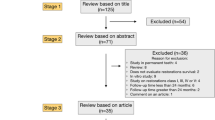Abstract
Design This study is a parallel group randomised un-blinded trial with equal allocation to evaluate and compare the success of ART with HVGIC and composite restorations in class II cavities in permanent molars.
Study population The study populations included 154 participants who were selected from 17 different schools of Bauru and adjoining areas in Sao Paulo, Brazil. Children with good general and oral health and having 1 or 2 class II cavities were chosen. Only one restoration per child which exhibited good occlusal contact was finally chosen for the purpose of study. The participants were then stratified as per DMFT-score and cavity size. After stratifying the participants in four conglomerates, they were randomly allocated to either ART with HVGIC or composite restoration group. Later, the participants were recalled at 6 and 12 months and the restorations were evaluated using ART and modified-USPHS criteria.
Data analysis Frequency statistics, which included chi square, chi square for trend and Fisher's exact test, were used for determining the association between restoration type and different baseline variables and for determining the association between distribution of scores obtained with ART and composite restorations for different evaluation criteria.
Results With ART criteria, success rates of ART and composite restoration were found to be 98.7% and 100% at 6 months while at 12 months the success rates were observed to be 98.7% and 95.8%, respectively. The distribution of scores at both the time periods was found to be statistically significant (p = 0.033). Same success rates were observed when the restorations were evaluated using modified-USPHS criteria, with statistical difference at the 6 month post-operative recall (p = 0.001), and non-significant difference at the 12 month recall visit (p = 0.310). Survival rates of ART and composite restoration were observed to be 94.8% and 98.7% with no-significant difference in the survival curves (p = 0.173)
Conclusions In class II cavities in permanent molars, ART restorations with high viscosity GIC, done in a school setting exhibited similar success rates as composite restoration done in a clinical setting.
This is a preview of subscription content, access via your institution
Access options
Subscribe to this journal
Receive 4 print issues and online access
$259.00 per year
only $64.75 per issue
Buy this article
- Purchase on Springer Link
- Instant access to full article PDF
Prices may be subject to local taxes which are calculated during checkout
Similar content being viewed by others
References
Rasines Alcaraz M G, Veitz-Keenan A, Sahrmann P, Schmidlin P R, Davis D, Iheozor-Ejiofor Z. Direct composite resin fillings versus amalgam fillings for permanent or adult posterior teeth. Cochrane Database Syst Rev 2014; DOI: 10.1002/14651858.CD005620.pub2.
Kielbassa A M, Glockner G, Wolgin M, Glockner K. Systematic review on highly viscous glass-ionomer cement/resin coating restorations (Part II): Do they merge Minamata Convention and minimum intervention dentistry? Quintessence Int 2017; 48: 9-18.
AAPD recommendations. Pediatric Restorative Dentistry, 2019. Available at https://www.aapd.org/globalassets/media/policies_guidelines/bp_restorativedent.pdf (accessed February 2020).
Mickenautsch S. High-viscosity glass-ionomer cements for direct posterior tooth restorations in permanent teeth: The evidence in brief. J Dent 2016; 55: 121-123.
Author information
Authors and Affiliations
Rights and permissions
About this article
Cite this article
Gugnani, N., Gugnani, S. ART with high viscosity GIC and composite restorations in class II cavities: can they thrive in the post-amalgam era?. Evid Based Dent 21, 22–23 (2020). https://doi.org/10.1038/s41432-020-0078-6
Published:
Issue Date:
DOI: https://doi.org/10.1038/s41432-020-0078-6



